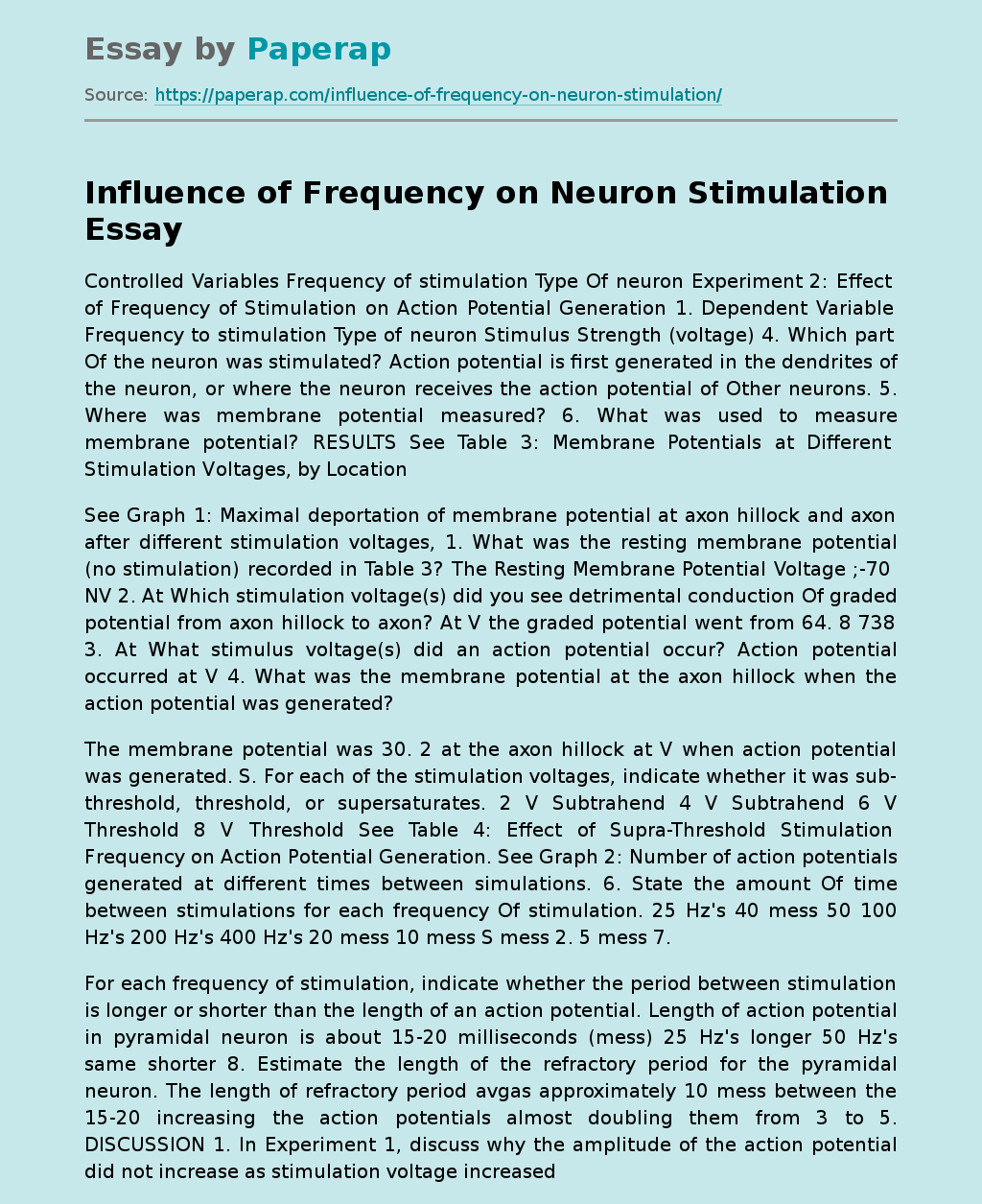Influence of Frequency on Neuron Stimulation
Controlled Variables Frequency of stimulation Type Of neuron Experiment 2: Effect of Frequency of Stimulation on Action Potential Generation 1. Dependent Variable Frequency to stimulation Type of neuron Stimulus Strength (voltage) 4. Which part Of the neuron was stimulated? Action potential is first generated in the dendrites of the neuron, or where the neuron receives the action potential of Other neurons. 5. Where was membrane potential measured? 6. What was used to measure membrane potential? RESULTS See Table 3: Membrane Potentials at Different Stimulation Voltages, by Location
See Graph 1: Maximal deportation of membrane potential at axon hillock and axon after different stimulation voltages, 1.
What was the resting membrane potential (no stimulation) recorded in Table 3? The Resting Membrane Potential Voltage ;-70 NV 2. At Which stimulation voltage(s) did you see detrimental conduction Of graded potential from axon hillock to axon? At V the graded potential went from 64. 8 738 3. At What stimulus voltage(s) did an action potential occur? Action potential occurred at V 4. What was the membrane potential at the axon hillock when the action potential was generated?
The membrane potential was 30.
2 at the axon hillock at V when action potential was generated. S. For each of the stimulation voltages, indicate whether it was sub-threshold, threshold, or supersaturates. 2 V Subtrahend 4 V Subtrahend 6 V Threshold 8 V Threshold See Table 4: Effect of Supra-Threshold Stimulation Frequency on Action Potential Generation. See Graph 2: Number of action potentials generated at different times between simulations. 6. State the amount Of time between stimulations for each frequency Of stimulation. 25 Hz’s 40 mess 50 100 Hz’s 200 Hz’s 400 Hz’s 20 mess 10 mess S mess 2.
5 mess 7.
For each frequency of stimulation, indicate whether the period between stimulation is longer or shorter than the length of an action potential. Length of action potential in pyramidal neuron is about 15-20 milliseconds (mess) 25 Hz’s longer 50 Hz’s same shorter 8. Estimate the length of the refractory period for the pyramidal neuron. The length of refractory period avgas approximately 10 mess between the 15-20 increasing the action potentials almost doubling them from 3 to 5. DISCUSSION 1. In Experiment 1, discuss why the amplitude of the action potential did not increase as stimulation voltage increased above threshold.
All-or-nothing theory….. Once the threshold is met, a refractory period is needed. All and then nothing, repeat…. 2. In Experiment 1, explain why the membrane potential between the axon hillock and axon either changed or did not change with subtrahend stimulus. Differences of NV or less are not significant, It did not change, Unless the deportation occurs, the sodium ions cannot enter created change. This only happens at the threshold, 3. In Experiment 2, explain why the membrane potential between the axon lock and axon either changed or did not change with threshold stimulus.
Differences of I NV or less are not significant . It did not change Unless the 4. In Experiment 2, explain why the number of action potentials generated varied With increased stimulation frequency. Action potentials can occur more frequently as long there is a continued source of stimulation, as long as the relative refractory period has been reached, Which in experiment 2 the refractory period was complete. 5. Restate your predictions that were correct and give the data from your experiment that supports them.
Restate your predictions that were not correct and correct them, giving the data from your experiment that supports the correction, 1) Exceeding threshold deportation does not change the likelihood to an action potential being produced, Due to the need for a refractory period this is (all or nothing) In the experiment from V-V in the axon hillock the difference in amplitude went from 30. 2 to 30. 9 (not a remarkable increase) 2) Amplitude does not change with distance, From the experiment, the action potential amplitude does NOT change as it propagates down the axon. (The change was small at 0. C,2) 3) Increasing frequency of stimulation of the trigger zone does not increases the production of the action potentials. This goes back to the threshold All or nothing theory. APPLICATION 1. KEF potassium levels affect resting membrane potential. Hyperemia (excessive levels of potassium in the blood) and hypoglycemia (abnormally low blood potassium levels) both affect the function of nerves and muscles. Explain how hyperemia will initially affect the resting membrane potential and the generation of an action potential. Hyperemia depilatories muscle cells, reducing the membrane potential from -90 NV to approximately -80 NV.
Influence of Frequency on Neuron Stimulation. (2018, May 24). Retrieved from https://paperap.com/influence-of-frequency-on-neuron-stimulation/

